
Fort Delimara
Encyclopedia
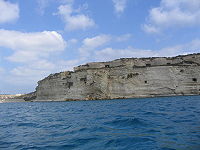
Fortification
Fortifications are military constructions and buildings designed for defence in warfare and military bases. Humans have constructed defensive works for many thousands of years, in a variety of increasingly complex designs...
in Marsaxlokk
Marsaxlokk
Marsaxlokk is a traditional fishing village located in the south-eastern part of Malta, with a population of 3,277 people . The village’s name comes from marsa, which means "port" and xlokk, which is the local name for south east...
, Malta
Malta
Malta , officially known as the Republic of Malta , is a Southern European country consisting of an archipelago situated in the centre of the Mediterranean, south of Sicily, east of Tunisia and north of Libya, with Gibraltar to the west and Alexandria to the east.Malta covers just over in...
.
History
The fort was built between 1876 and 1888 by the BritishBritish Empire
The British Empire comprised the dominions, colonies, protectorates, mandates and other territories ruled or administered by the United Kingdom. It originated with the overseas colonies and trading posts established by England in the late 16th and early 17th centuries. At its height, it was the...
. The main gate carries a date of 1881, but this is the date of completion of the gatehouse, not the commissioning of the fort.
Fort Delimara was a one of a ring of forts and batteries that protected Marsaxlokk
Marsaxlokk
Marsaxlokk is a traditional fishing village located in the south-eastern part of Malta, with a population of 3,277 people . The village’s name comes from marsa, which means "port" and xlokk, which is the local name for south east...
harbour, along with Fort Tas-Silg
Fort Tas-Silg
Fort Tas-Silġ is a fortification on the island of Malta. It stands on high ground at the shoreward end of Delimara Point, above Il-Ħofra-z-Zgħira. It is a Polygonal fort and was built by the British. Its primary function was as a fire control point controlling the massed guns of Fort Delimara on...
at the shoreward end of Delimara point, Fort St Lucian
St Lucian Tower
St Lucian Tower is a fortification on the island of Malta that stands above the shore of Marsaxlokk Bay on the headland between Marsaxlokk and Birzebbuga.It was built by the Knights of Malta between 1610 and 1611 and is one of a series of Wignacourt towers....
on Kbira point in the middle of Marsaxlokk bay, Fort Benghisa
Fort Benghisa
Fort Benghisa is a fortification on the island of Malta. It stands on high ground on the seaward face of Benghisa point, the southern arm of Marsaxlokk Bay...
on Benghisa Point, and the Pinto and Ferreti batteries on the shores of Marsaxlokk Bay.
In 1956 the fort was stripped of the majority of its artillery
Artillery
Originally applied to any group of infantry primarily armed with projectile weapons, artillery has over time become limited in meaning to refer only to those engines of war that operate by projection of munitions far beyond the range of effect of personal weapons...
. Soon after, the fort was abandoned for a considerable period, and in 1975 it was leased by the Malta Government to a local farmer, who used it to raise pigs for fifteen years.
After protracted negotiations, ownership of Fort Delimara was transferred to Heritage Malta
Heritage Malta
Heritage Malta is the Maltese national agency for museums, conservation practice and cultural heritage. Created by the Cultural Heritage Act, enacted in 2002, the national agency replaced the former Museums Department....
on August 11, 2005. Despite the pigs and a considerable amount of modern debris, the fort remains in decent condition, and still retains four of its original complement of fourteen Victorian
Victorian era
The Victorian era of British history was the period of Queen Victoria's reign from 20 June 1837 until her death on 22 January 1901. It was a long period of peace, prosperity, refined sensibilities and national self-confidence...
12.5-inch 38 ton rifled muzzle-loading guns
RML 12.5 inch 38 ton gun
The RML 12.5 inch guns were large rifled muzzle-loading guns designed for British battleships and were also employed for coast defence.-Design:The gun originated from a desire for a longer 12-inch gun than the existing RML 12 inch 35 ton gun...
.
Heritage Malta intends to restore the site to its former condition, and open it to the public as a Museum
Museum
A museum is an institution that cares for a collection of artifacts and other objects of scientific, artistic, cultural, or historical importance and makes them available for public viewing through exhibits that may be permanent or temporary. Most large museums are located in major cities...
http://delimara-preservation-society.malta-site.com] and tourist site.
Details of the fort
Fort Delimara is mostly underground, with the fort's main armament mounted in casemates set in the cliffs on the shoreward face of Delimara Point. At the surface it is a polygonal fortPolygonal fort
A polygonal fort is a fortification in the style that evolved around the middle of the nineteenth century, in response to the development of powerful explosive shells....
, rectangular in outline, with rock cut ditches on three sides, and the gently curving vertical cliff forming the convex fourth side. Ventilation apertures and access passageways are spread out across the face of the cliff, and even out onto the seaward face of Point Delimara.
Gatehouse
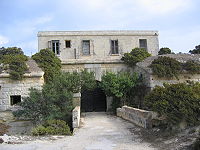
Counterscarp
A scarp and a counterscarp are the inner and outer sides of a ditch used in fortifications. In permanent fortifications the scarp and counterscarp may be encased in stone...
faced in earth and rubble. A stone parapet
Parapet
A parapet is a wall-like barrier at the edge of a roof, terrace, balcony or other structure. Where extending above a roof, it may simply be the portion of an exterior wall that continues above the line of the roof surface, or may be a continuation of a vertical feature beneath the roof such as a...
with rifle
Rifle
A rifle is a firearm designed to be fired from the shoulder, with a barrel that has a helical groove or pattern of grooves cut into the barrel walls. The raised areas of the rifling are called "lands," which make contact with the projectile , imparting spin around an axis corresponding to the...
loops runs along the top of the north scarp. A square building above the gate may be a later addition from the early twentieth century, when the fort was used as a military base
Military base
A military base is a facility directly owned and operated by or for the military or one of its branches that shelters military equipment and personnel, and facilitates training and operations. In general, a military base provides accommodations for one or more units, but it may also be used as a...
long after its surface fortifications were obsolete. A World War II
World War II
World War II, or the Second World War , was a global conflict lasting from 1939 to 1945, involving most of the world's nations—including all of the great powers—eventually forming two opposing military alliances: the Allies and the Axis...
vintage pillbox has been erected inside the Victorian fortification, and shows above the fort's profile when viewed from the sea.
The gatehouse
Gatehouse
A gatehouse, in architectural terminology, is a building enclosing or accompanying a gateway for a castle, manor house, fort, town or similar buildings of importance.-History:...
faces toward the landward end of Delimara Point, reached by a tarmac road that runs outside the north ditch. The gatehouse is close to the seaward end of the north ditch.
Counterscarp battery
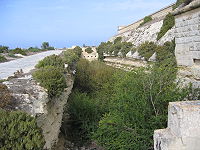
East and south ditches
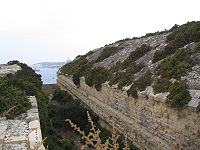
Glacis
A glacis in military engineering is an artificial slope of earth used in late European fortresses so constructed as to keep any potential assailant under the fire of the defenders until the last possible moment...
in front of the gatehouse has probably been reduced at some time to make road access easier, and the rolling bridge that would originally have crossed the ditch has been replaced by a permanent bridge. The road to Delimara Lighthouse along the east ditch of the fort disrupts the glacis on this face as well. The glacis is more intact along the south ditch, giving a better impression of how the fort would have looked when originally built.
Seaward face and gun emplacements

RML 12.5 inch 38 ton gun
The RML 12.5 inch guns were large rifled muzzle-loading guns designed for British battleships and were also employed for coast defence.-Design:The gun originated from a desire for a longer 12-inch gun than the existing RML 12 inch 35 ton gun...
. The casemates are grouped in pairs close to the cliff top, capped by an earth and rubble slope, and follow the natural curve of the cliff face, giving them a combined field of fire that covers the majority of Marsaxlokk harbour.
Present condition
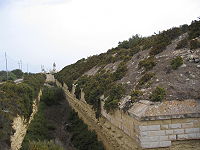
Limestone
Limestone is a sedimentary rock composed largely of the minerals calcite and aragonite, which are different crystal forms of calcium carbonate . Many limestones are composed from skeletal fragments of marine organisms such as coral or foraminifera....
faces of the scarp and counterscarp have eroded substantially since they were originally cut, in places to a depth of as much as a metre. In some cases this erosion has reached the point that the revetting collapses into the ditch.
Where the road to Delimara Lighthouse runs along the east ditch of the fort, directly above the counterscarp face of the ditch a section of perhaps ten metres the counterscarp has collapsed into the ditch, and threatens the stability of the road. The resulting rubble fall can be seen in the image of the east ditch.
The ditch is also considerably overgrown, and polluted with general rubbish, unfortunately true of all the Victorian forts in Malta. There is currently no public access to the interior of the fort.
External links
- http://www.di-ve.com/dive/portal/portal.jhtml?id=194438&pid=23
- http://217.145.4.56/ind/news.asp?newsitemid=19939
- http://delimara-preservation-society.malta-site.com

